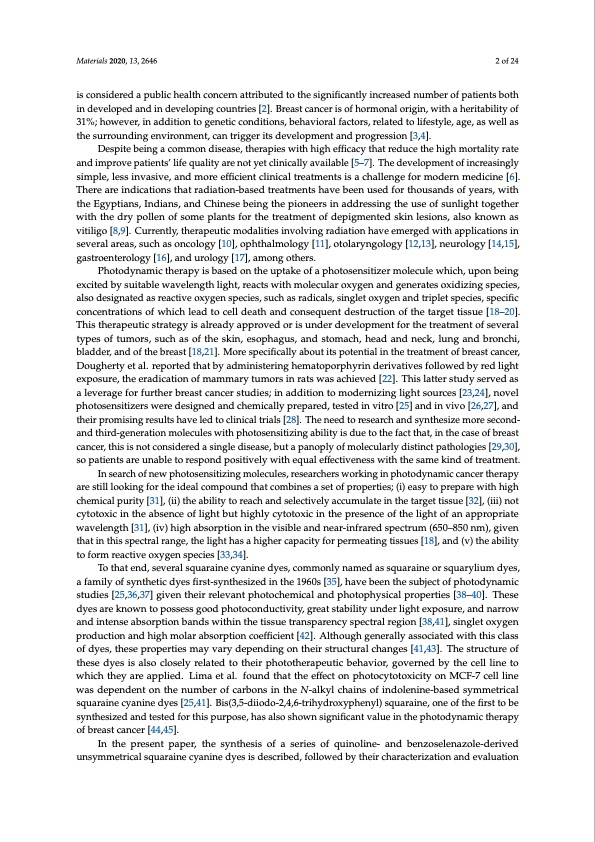
PDF Publication Title:
Text from PDF Page: 002
Materials 2020, 13, 2646 2 of 24 is considered a public health concern attributed to the significantly increased number of patients both in developed and in developing countries [2]. Breast cancer is of hormonal origin, with a heritability of 31%; however, in addition to genetic conditions, behavioral factors, related to lifestyle, age, as well as the surrounding environment, can trigger its development and progression [3,4]. Despite being a common disease, therapies with high efficacy that reduce the high mortality rate and improve patients’ life quality are not yet clinically available [5–7]. The development of increasingly simple, less invasive, and more efficient clinical treatments is a challenge for modern medicine [6]. There are indications that radiation-based treatments have been used for thousands of years, with the Egyptians, Indians, and Chinese being the pioneers in addressing the use of sunlight together with the dry pollen of some plants for the treatment of depigmented skin lesions, also known as vitiligo [8,9]. Currently, therapeutic modalities involving radiation have emerged with applications in several areas, such as oncology [10], ophthalmology [11], otolaryngology [12,13], neurology [14,15], gastroenterology [16], and urology [17], among others. Photodynamic therapy is based on the uptake of a photosensitizer molecule which, upon being excited by suitable wavelength light, reacts with molecular oxygen and generates oxidizing species, also designated as reactive oxygen species, such as radicals, singlet oxygen and triplet species, specific concentrations of which lead to cell death and consequent destruction of the target tissue [18–20]. This therapeutic strategy is already approved or is under development for the treatment of several types of tumors, such as of the skin, esophagus, and stomach, head and neck, lung and bronchi, bladder, and of the breast [18,21]. More specifically about its potential in the treatment of breast cancer, Dougherty et al. reported that by administering hematoporphyrin derivatives followed by red light exposure, the eradication of mammary tumors in rats was achieved [22]. This latter study served as a leverage for further breast cancer studies; in addition to modernizing light sources [23,24], novel photosensitizers were designed and chemically prepared, tested in vitro [25] and in vivo [26,27], and their promising results have led to clinical trials [28]. The need to research and synthesize more second- and third-generation molecules with photosensitizing ability is due to the fact that, in the case of breast cancer, this is not considered a single disease, but a panoply of molecularly distinct pathologies [29,30], so patients are unable to respond positively with equal effectiveness with the same kind of treatment. In search of new photosensitizing molecules, researchers working in photodynamic cancer therapy are still looking for the ideal compound that combines a set of properties; (i) easy to prepare with high chemical purity [31], (ii) the ability to reach and selectively accumulate in the target tissue [32], (iii) not cytotoxic in the absence of light but highly cytotoxic in the presence of the light of an appropriate wavelength [31], (iv) high absorption in the visible and near-infrared spectrum (650–850 nm), given that in this spectral range, the light has a higher capacity for permeating tissues [18], and (v) the ability to form reactive oxygen species [33,34]. To that end, several squaraine cyanine dyes, commonly named as squaraine or squarylium dyes, a family of synthetic dyes first-synthesized in the 1960s [35], have been the subject of photodynamic studies [25,36,37] given their relevant photochemical and photophysical properties [38–40]. These dyes are known to possess good photoconductivity, great stability under light exposure, and narrow and intense absorption bands within the tissue transparency spectral region [38,41], singlet oxygen production and high molar absorption coefficient [42]. Although generally associated with this class of dyes, these properties may vary depending on their structural changes [41,43]. The structure of these dyes is also closely related to their phototherapeutic behavior, governed by the cell line to which they are applied. Lima et al. found that the effect on photocytotoxicity on MCF-7 cell line was dependent on the number of carbons in the N-alkyl chains of indolenine-based symmetrical squaraine cyanine dyes [25,41]. Bis(3,5-diiodo-2,4,6-trihydroxyphenyl) squaraine, one of the first to be synthesized and tested for this purpose, has also shown significant value in the photodynamic therapy of breast cancer [44,45]. In the present paper, the synthesis of a series of quinoline- and benzoselenazole-derived unsymmetrical squaraine cyanine dyes is described, followed by their characterization and evaluationPDF Image | Photophysicochemical Light Antiproliferative vs cancer

PDF Search Title:
Photophysicochemical Light Antiproliferative vs cancerOriginal File Name Searched:
materials-13-02646-v2.pdfDIY PDF Search: Google It | Yahoo | Bing
Cruise Ship Reviews | Luxury Resort | Jet | Yacht | and Travel Tech More Info
Cruising Review Topics and Articles More Info
Software based on Filemaker for the travel industry More Info
The Burgenstock Resort: Reviews on CruisingReview website... More Info
Resort Reviews: World Class resorts... More Info
The Riffelalp Resort: Reviews on CruisingReview website... More Info
| CONTACT TEL: 608-238-6001 Email: greg@cruisingreview.com | RSS | AMP |